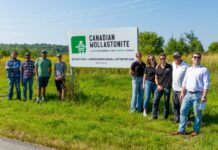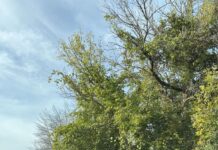submitted by Fred Schueler
After it was formed by provincial amalgamation of three municipalities, North Grenville burdened itself with the paradoxical motto “Green & Growing,” and soon had the “growing” term, which had been triggered by the increased capacity of Kemptville’s sewage-treatment plant, enhanced by the construction of Highway 416, with its facilitation of daily commuting to jobs in Ottawa. The construction of housing for these commuters severely strained the “green” part of the motto, and Kemptville, for example, lost its most distinctive feature: the spring migration of Leopard Frogs from hibernation in the creek around Hurd Street to breeding in the swamps north of Highway 43.
If we’re going to be “green,” we’d better attend to proposals for a “green new deal” which combine emergence from the pandemic with action to mitigate and offset climate change. The Council of Canadians has “Whereas & Therefore-be-it-resolved” resolutions for such a transformation on their website at https://canadians.org/wp-content/uploads/2019/06/greennewdeal-guide.pdf as a document linked through the pdf document, and I’ll use some of the language of this, though the reader is warned that this discussion is informed by my radically ecocentric, servants-of-the-land point of view.
I suggest that the human population of North Grenville recognize that they live as guests and caretakers within “green and growing” ecological communities of other species, while recognizing both the urgency of the climate crisis and the partitionings of responsibility imposed by the Canadian political system. A “Green New Deal” will ensure that transformation is carried out equitably, that it is rooted in climate justice, that it respects the rights of Indigenous peoples, and that it creates jobs in the process.
We should all be aware that we are living on an Ordovician limestone plain, the recent retreat of the ice, post-glacial flooding by the Champlain Sea, the retreat of the sea as the earth rebounded from the weight of the glaciers, and that our land has been occupied and managed by people for as long as it has been exposed, most recently as a boundary territory between Algonquin and Iroquoian peoples, and then through the fur trade and Loyalist settlement.
On the basic ecological side, we should engage in land use which promotes natural biodiversity and retains mineral nutrients in terrestrial communities, so that streams have the low levels of nutrients to which native species are adapted. In co-operation with Conservation Authorities, the municipality should model and understand the flow of water through precipitation, runoff, infiltration, transpiration, drains, streams, and aquifers, and how human use affects these. There should be a corresponding effort to measure and analyse the carbon stored, and methane emissions from, the forests, soils, and wetlands of North Grenville, in order to form a plan to maximize carbon stored in these communities.
We should actively discourage invasive plants and animals from becoming established, while native species with limited dispersal ability, that were extirpated by past land use practices, are reintroduced into the new habitats produced by reforestation or secondary ecological succession. We should preserve all local ecological communities of limited extent – wetlands, rock faces, streams, prairie-like grasslands and distinctive forests – and we should each learn to recognize as many species, and their roles in the ecosystem, as possible.
We should look forward to having roads managed to minimize roadkill of wildlife, to having some land managed as prairie-like meadows to support species which occupied the pastures of previous agricultural practices, and to having the extent of lawns minimized, with what are now overly broad lawns planted with biodiverse carbon-sequestering groves of trees.
We should expect that in line with the Intergovernmental Panel on Climate Change, the municipality will ensure a reduction of at least 30% in municipal government emissions by 2025, and a 50% reduction by 2030, in part by installing renewable energy systems, such as to-scale solar, wind, and/or heat pumps, on municipal facilities.
We should look forward to action from all levels of government to ensure equitable distribution of wealth through the human population, support for those who are emotionally distressed, and effective action in support of those who have been discriminated against on the basis of culture, sexual orientation, or “race.”
There should be progress toward systems for transportation which emit minimal greenhouse gases, including public transit and continued support for cycling and pedestrian infrastructure.
We should minimize the area needed for housing by zoning that maximizes the use made of built-up land, encouragement of multi-generational households and friendliness in the taking-in of the homeless and wanderers, reduced exploitation of renters by commercial landlords, and support for insulation, heat-pumps, and roof-top solar panels to maximize the efficiency of housing, while reducing residential greenhouse gas emissions towards 50% by 2030 and 100% by 2050.
Procedures and research should minimize waste and encourage recycling, directing as much organic household waste as possible to backyard composting and/or chickens. The municipality should eliminate any barriers to residents growing their own food and should increase opportunities for community gardens. By-laws that encourage mowed lawns should be replaced by ones that support the growth of pollinator-friendly plants around homesites.
To minimize corporate influence and capture of regulatory and governance processes on climate action, all candidates for municipal council should declare any support they have received from development corporations, and recuse themselves from decisions that affect any of their campaign donors.
Progress on this kind of issues is slow and difficult, and the comparison is often made with mobilizations for the World Wars of the 20th Century. Denialists raise the cry, in the words of the classic cartoon, “What if it’s all a hoax, and we create a better world for nothing?”, there are possibilities of “positive feedback loops” in melting permafrost or hydrated seabed methane, and any area’s contribution to controlling greenhouse gases will be a minute fraction of what’s needed globally, but a unique opportunity is presented for everyone to work together for the first time to understand human occupancy of the Earth on a planetary scale. If North Grenville can move forward in this way, it’s an opportunity for our community to be a leader in responding to the global crisis. The present council has made good progress on some of these fronts, but this is the time, and we have the opportunity, to do much more. I hope this squeezing-down of the huge problem into a few paragraphs has been helpful.









Very nicely put. Fred Schueler shows us that each of us can make a difference and together, as a community, we can have a real impact on making our environment better.